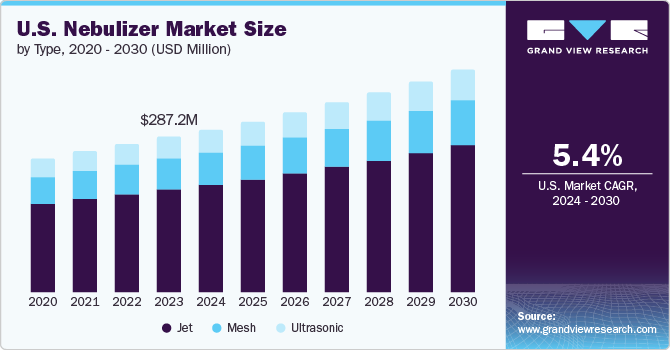- Home
- »
- Medical Devices
- »
-
U.S. Nebulizer Market Size & Share, Industry Trends Report, 2018-2025GVR Report cover
![U.S. Nebulizer Market Size, Share & Trends Report]()
U.S. Nebulizer Market Size, Share & Trends Analysis Report By Product (Pneumatic (Standalone, Portable), Ultrasonic, Mesh), Competitive Landscape, And Segment Forecasts, 2018 - 2025
- Report ID: GVR-2-68038-085-9
- Number of Report Pages: 78
- Format: PDF, Horizon Databook
- Historical Range: 2014 - 2015
- Forecast Period: 2017 - 2025
- Industry: Healthcare
Industry Insights
The U.S. nebulizer market size was valued at USD 254.2 million in 2016 and is expected to expand at a CAGR of 6.2% over the forecast period. Rising geriatric population, increasing incidence of chronic respiratory diseases, and surging demand for home healthcare devices have been contributing to market growth.
According to statistics published by the Centers for Disease Control and Prevention (CDC), approximately 18.4 million adults in U.S. suffer from asthma. Initiatives such as the “Global Alliance Against Chronic Respiratory Diseases” are likely to improve diagnosis and treatment rates of respiratory disorders, which may in turn boost the U.S. market for nebulizers. In addition, factors such as unhealthy diet, overconsumption of tobacco and alcohol, lack of physical activity, and rising rate of obesity are likely to lead to increasing incidence of respiratory disorders, which in turn, will contribute to market growth over the forecast period.

Home healthcare is a cost-effective alternative to expensive hospital stays. In recent years, home healthcare devices have been gaining popularity as well as market share, driving market growth over the forecast period. Miniaturization of products and technological advancements are boosting the adoption of home healthcare devices. Furthermore, growing geriatric population, high incidence of target diseases, and rising need to curb healthcare expenditure are expected to up the adoption of home healthcare devices. Easy availability of compact nebulizers ideal for home use and technological innovations to reduce sound and improve functionality are also increasing their adoption in home healthcare.
The usage of nebulizers is also expected to be driven by growing geriatric population in U.S. According to the Population Reference Bureau report, “Aging in the United States”, geriatric population in U.S. is estimated to increase from 48.0 million in 2016 to 98.0 million by 2060. Elderly people are more susceptible to respiratory diseases such as chronic obstructive pulmonary disease (COPD) and sleep apnea compared to other demographic groups. Therefore, growing geriatric population forms a key patient pool for manufacturers. Technological innovations to make devices compact and portable and improve their effectiveness are also boosting their uptake. Portable nebulizers are being increasingly adopted by U.S. patients owing to their easy and convenient usage and launch of several new products in recent years.
Product Insights
The U.S. nebulizer market, on the basis of product, is segmented into pneumatic, ultrasonic, and mesh. The pneumatic and ultrasonic nebulizer segments are further broken down into standalone and portable types. The mesh nebulizer segment is anticipated to witness the highest growth over the forecast period, driven by efficacy and effectiveness offered by these devices, and technological advancements in the product segment.
The pneumatic nebulizer segment commanded the largest market share in 2016. High prevalence of respiratory disorders among the aging population has contributed to the dominance of these devices in the market. As per WHO, the primary cause of COPD is tobacco smoke; therefore, increase in number of smokers and rising levels of air pollution may lead to growth in demand for these devices.
Nebulizer Market Share Insights
Some of the major players operating in this market are Omron Corporation; Koninklijke Philips N.V.; PARI Pharma; Allied Healthcare Products, Inc.; Becton, Dickinson and Company; Agilent Technologies; Medline Industries, Inc.; Briggs Healthcare; Drive Medical; and GF Health Products, Inc.
These key market players are adopting various strategies such as mergers and acquisitions, product approvals, and agreements to increase product reach and strengthen their product portfolios. For instance, in September 2016, Medline Industries, Inc. bagged a distribution agreement with Wisconsin Hospice collaborative. This agreement is expected to benefit both parties by promoting cost-efficiency and boosting business. The Wisconsin Hospice collaborative catered to about 700 individuals per day as of 2016, warranting the need for routine supplies. In November 2015, CareFusion Airlife signed an agreement with ResMed to distribute the latter’s nasal high flow interface products.
Report Scope
Attribute
Details
Base year for estimation
2016
Actual estimates/Historical data
2014 - 2015
Forecast period
2017 - 2025
Market representation
Revenue in USD Million & CAGR from 2017 to 2025
Report coverage
Revenue, units sold, competitive landscape, growth factors, and trends
15% free customization scope (equivalent to 5 analysts working days)
If you need specific market information, which is not currently within the scope of the report, we will provide it to you as a part of customization
Segments Covered in the ReportThis report forecasts revenue growth and provides an analysis on latest industry trends in each of the sub-segments from 2014 to 2025. For the purpose of this study, Grand View Research, Inc. has segmented the U.S. nebulizer market report on the basis of product:
-
Product Outlook (Revenue, USD Million, 2014 - 2025)
-
Pneumatic
-
Standalone
-
Portable
-
-
Ultrasonic
-
Standalone
-
Portable
-
-
Mesh
-
-
Product Outlook (Volume, Units Sold, 2014 - 2025)
-
Pneumatic
-
Standalone
-
Portable
-
-
Ultrasonic
-
Standalone
-
Portable
-
-
Mesh
-
Share this report with your colleague or friend.
![gvr icn]()
NEED A CUSTOM REPORT?
We can customize every report - free of charge - including purchasing stand-alone sections or country-level reports, as well as offer affordable discounts for start-ups & universities. Contact us now
![Certified Icon]()
We are GDPR and CCPA compliant! Your transaction & personal information is safe and secure. For more details, please read our privacy policy.
We are committed towards customer satisfaction, and quality service.
"The quality of research they have done for us has been excellent."





